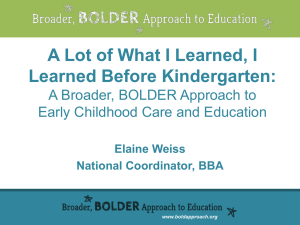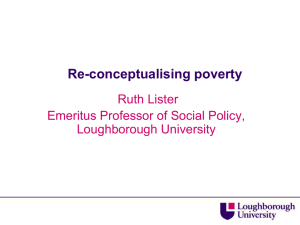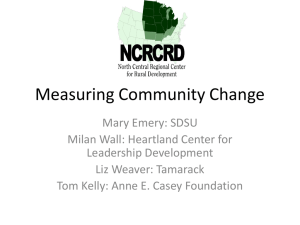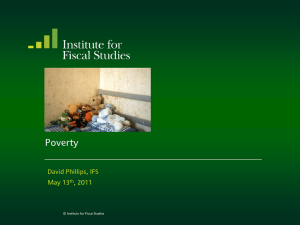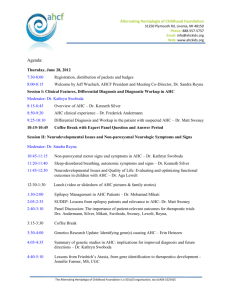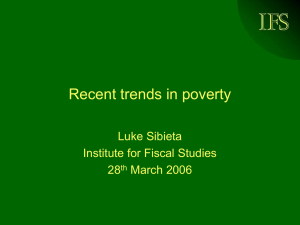Child poverty presentation
advertisement
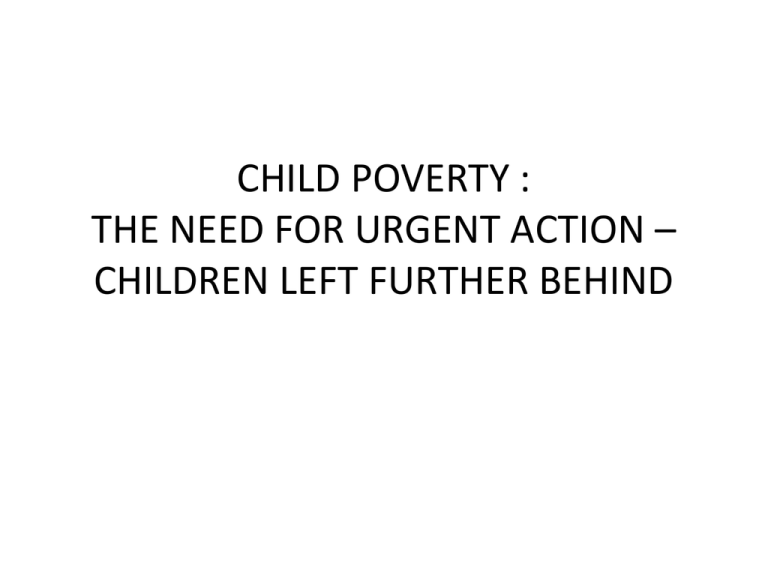
CHILD POVERTY : THE NEED FOR URGENT ACTION – CHILDREN LEFT FURTHER BEHIND BACKGROUND ISSUES • WHAT DO WE MEAN BY CHILD POVERTY – INCOME – LIVING STANDARDS • WHY IT MATTERS – POSITION OF CHILDREN: NOW AND AS FUTURE CITIZENS • CHILDREN : WHOSE RESPONSIBILITY ? KEY POLICY QUESTIONS • WORKING FOR FAMILIES – DISCRIMINATION – HIGH COURT CASE • CHILD POVERTY (21%) AND POVERTY AMONG OLDER PEOPLE (7%) • A MATTER OF POLITICAL WILL SOME DATA • APPROXIMATELY 20% LIVING BELOW 60% AHC POVERTY LINE • LIVING STANDARDS • RECENT NEW ZEALAND REPORTS – – – – – MINISTRY OF SOCIAL DEVELOPMENT EVERY CHILD COUNTS TE ARA HOU NATIONAL CHILD AND YOUTH HEALTH MONITORING CHILD POVERTY ACTION GROUP Numbers of poor children in New Zealand (ie the number of children in households with incomes below the selected thresholds) BHC AHC BHC ‘moving AHC ‘moving AHC ‘moving line’ 60% line’ 50% line’ 60% AHC ‘fixed line’ 60% (07 ref) 2001 250,000 215,000 310,000 380,000 2004 270,000 200,000 290,000 320,000 2007 210,000 170,000 240,000 240,000 2009 210,000 190,000 270,000 230,000 2010 215,000 170,000 270,000 230,000 Child poverty rates (%) in selected European countries, Canada, the US, Mexico and Australia. c 2009: 60% of median threshold (BHC) Turkey 2006 Mexico 2004 United States 2004 Latvia Canada 2004 Italy Spain Lithuania Greece Poland Portugal Luxembourg Australia 2003 Estonia United Kingdom Hungary 36 30 29 26 25 24 24 24 24 23 23 22 22 21 21 21 New Zealand 2009 EU-27 average Ireland Belgium France Slovak Republic Germany Netherlands Austria Czech Republic Sweden Finland Norway Slovenia Denmark Iceland 20 20 19 17 17 16 15 15 13 13 13 12 12 11 11 10 LIVING STANDARDS MEASURES • ACROSS WHOLE POPULATION • FOUR ELEMENTS: OWNERSHIP, SOCIAL PARTICIPATION, ECONOMISING, SELF RATING • SEVEN POINT SCALE: SEVERE HARDSHIP VERY GOOD Distribution of ELSI-3 scores for age groups (2008 50 46 Population percentage 40 31 30 27 25 23 22 22 22 20 26 23 23 20 17 15 14 14 12 11 10 10 10 10 9 9 7 8 6 8 8 6 6 6 2 2 2 3 0 0-17 years 18-24 years 25-44 years 45-64 years 65+ years ) Deprivation rates for children relative to overall population deprivation rate EU-25 - MT + NO + IS +NZ (EU 2007, NZ 2008) Ratio for deprivation rates - children:population 2.0 NZ 1.5 1.0 0.5 0.0 SI GR LT LV CY PT PL SK NO EE FI HU IT FR DK CZ AT IS DE ES NL BE SE LU IE NZ UK LEFT FURTHER BEHIND : A BRIEF SYNOPSIS • BACKGROUND – WORK, WHĀNAU ORA, PACIFIC CHILDREN • WORKING FOR FAMILIES AND TAX CREDITS • HEALTH AND WELLBEING • EDUCATION AND EMPLOYMENT • COSTS OF POVERTY KEY RECOMMENDATIONS • Monitor major indicators of child poverty and report these on a regular basis with specific target reductions to be met on the way to ending child poverty by 2020; and fund child-impact assessments of existing and future national and local policies; • Create a senior Cabinet position with responsibility for children, such as a Minister for Children, to support the move toward a child-centred approach to policy and legislation; • Remove work-based rules for child financial assistance and pay the equivalent of the In-Work- Tax-Credit to all low income families. Simplify administration of tax credits. Contd. • Acknowledge the vital social and economic contribution made by good parenting: ensure that affordable, appropriate childcare and early childhood education, including kohanga reo and playcentres, is available for all children; and ensure that training allowances support sole parents education where appropriate; • Provide free access to healthcare for all children under age six, 24 hours a day, 7 days a week; • The Government develop and fund a national housing plan to address the emerging housing shortages identified by the Department of Building. Meanwhile, ensure that housing is affordable and appropriate (eg address overcrowding, dampness, cold); • Provide adequate funding for low decile schools to ensure that all children have access to high quality education. EARLY CHILDHOOD EDUCATION – KEY RECOMMENDATIONS • Government commit to reducing reliance on private sector provision of early childhood education and care as a long-term objective, aligning the early childhood sector with primary education in terms of accepting government responsibility for both quality and access expectations in order to ensure equitable provision; • Government enable adequate funding provision to ensure that all early childhood education centres are fully staffed by qualified teachers, and further require ratios of teachers to children and unit sizes to be maintained in accord with quality guidelines; • Establish a model of ECE provision that is more intentional in terms of who it serves, where it is located and what else it provides to support parents and families; KEY RECOMMENDATIONS CONTD. • Base the new model of ECE provision on a neighbourhood by neighbourhood and a town by town assessment of future early childhood education needs; • Start thinking about travel distances in terms of pushing strollers rather than in terms of driving SUVs. COMPULOSORY EDUCATION KEY RECOMMENDATIONS • That the New Zealand Government acknowledge that international research suggests that the National Standards policy may have perverse and damaging effects; • That the Government investigate such effects thoroughly and respond accordingly rather than pushing ahead with the policy regardless of its impact; • That the Government look for ways to avoid further damage being created by ‘league tables’ of National Standards achievement, acknowledging that it is not feasible to take full account of school context in such tables; KEY RECOMMENDATIONS CONTD. • That the Government takes sustained action towards addressing the supply of quality teachers to low decile schools in ways that do not involve mirroring charity and business-based models which overseas research have shown to be largely ineffective; • That teacher education providers take greater account, in teacher education and postgraduate courses, of the social justice issues surrounding education and children in poverty; • That teacher education providers actively develop and promote courses for teachers wishing to teach in lower decile schools. Such courses would focus on empowering and culturally appropriate teaching and learning in lower socio-economic contexts. WHERE TO NOW ? • A NATIONAL COMMITMENT TO ACTION • SUSTAINED FOCUS ON THE NEEDS OF ALL CHILDREN • AND IN ADDITION,PARTICULARLY • ON THE NEEDS OF THE MOST DISADVANTAGED CHILDREN – POSITION OF MĀORI AND PACIFIC • CRUCIAL SIGNIFICANCE OF INVESTMENT FOR NOW AND FUTURE • SUSTAINED COMMITMENT SOURCES • CHILD POVERTY ACTION GROUP WWW.CPAG.ORG.NZ




